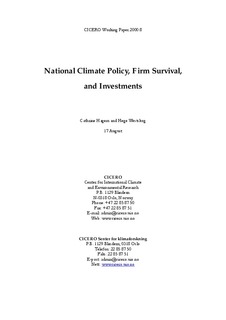| dc.contributor.author | Hagem, Cathrine | nb_NO |
| dc.contributor.author | Westskog, Hege | nb_NO |
| dc.date.accessioned | 2014-03-17T14:31:30Z | |
| dc.date.available | 2014-03-17T14:31:30Z | |
| dc.date.issued | 2000 | nb_NO |
| dc.identifier.issn | 0504-452X | nb_NO |
| dc.identifier.uri | http://hdl.handle.net/11250/192400 | |
| dc.description.abstract | In this paper we consider how to design a national tradable quota system to reduce emissions of climate gases when the regulator is concerned about the survival of specific firms. The problem is studied using a two-period model with a stochastic price in the second period. This enables us to include the effects of a chosen design of the tradable quota system on irreversible investment in abatement technology. We look at the social cost of ensuring firm survival for different ways of allocating free quotas and for different assumptions of whether an investment in abatement technology is cost minimizing or not.
Acknowledgements
We thank Michael Hoel and Asbjørn Torvanger for their valuable comments. | nb_NO |
| dc.language.iso | eng | nb_NO |
| dc.publisher | CICERO Center for International Climate and Environmental Research - Oslo | nb_NO |
| dc.relation.ispartof | CICERO Working Paper | nb_NO |
| dc.relation.ispartofseries | CICERO Working Paper;2000:08 | nb_NO |
| dc.title | National climate policy, firm survival, and investments | nb_NO |
| dc.type | Working paper | nb_NO |
| dc.source.pagenumber | | nb_NO |
